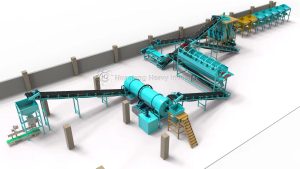In the increasingly strict environmental protection policies, fertilizer manufacturers are facing huge challenges, especially on organic fertilizer production lines and various fertilizer production lines, it is crucial to choose fertilizer equipment that meets the latest emission standards.
For the organic fertilizer production line, the raw materials are mostly organic waste such as livestock and poultry manure, crop straw, and improper treatment is easy to produce odor and harmful gases. Therefore, when choosing a fertilizer granulator, pay attention to its sealing performance. The high quality granulator adopts a multi-layer sealing structure to lock the odor from the feed port to the discharge port. It is equipped with an efficient exhaust gas collection interface to facilitate access to the subsequent deodorization system and ensure the production environment is up to standard.

In the fertilizer production line, different types of fertilizer granulators have their own advantages. Taking the common drum granulator as an example, it is necessary to consider whether its internal structure is conducive to the full reaction and granulation of the material when purchasing. The internal sheet of the new rotary drum granulator is specially designed to evenly turn the material, avoid local overheating and caking, improve the granulation rate and reduce dust emission. Its shell is made of high-temperature and corrosion-resistant special steel to cope with chemical corrosion in the fertilizer production process, extend the life of the equipment, and reduce the environmental burden caused by frequent equipment replacement.
Look at the collocation of the whole fertilizer production line, from the grinder, the blender to the granulator, the sifter, the connection of each link of equipment should be smooth. For example, the crusher needs to have the fine crushing ability to crush the raw materials to the appropriate particle size, which is conducive to subsequent granulation, and the dust cover and pulse dust removal device should be provided during the crushing process to prevent dust from spreading. The mixer should ensure that the material is mixed evenly, and the mixing blade design should be reasonable to avoid waste and environmental pollution caused by material splashing.
In short, the purchase of fertilizer equipment that meets the latest emission standards needs to be considered from many aspects of single machine performance and the whole line. Only by following the concept of environmental protection in each link can organic fertilizer production lines and fertilizer production lines operate efficiently, help the green and sustainable development of enterprises, and harvest Jinshan and Yinshan while protecting the green mountains and rivers.


